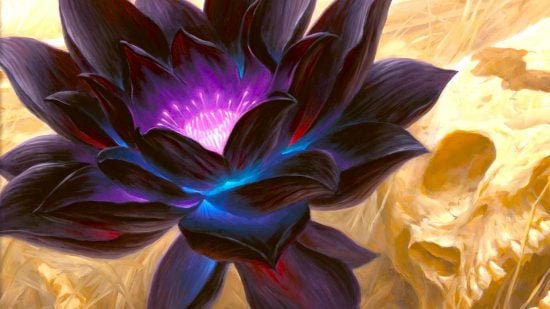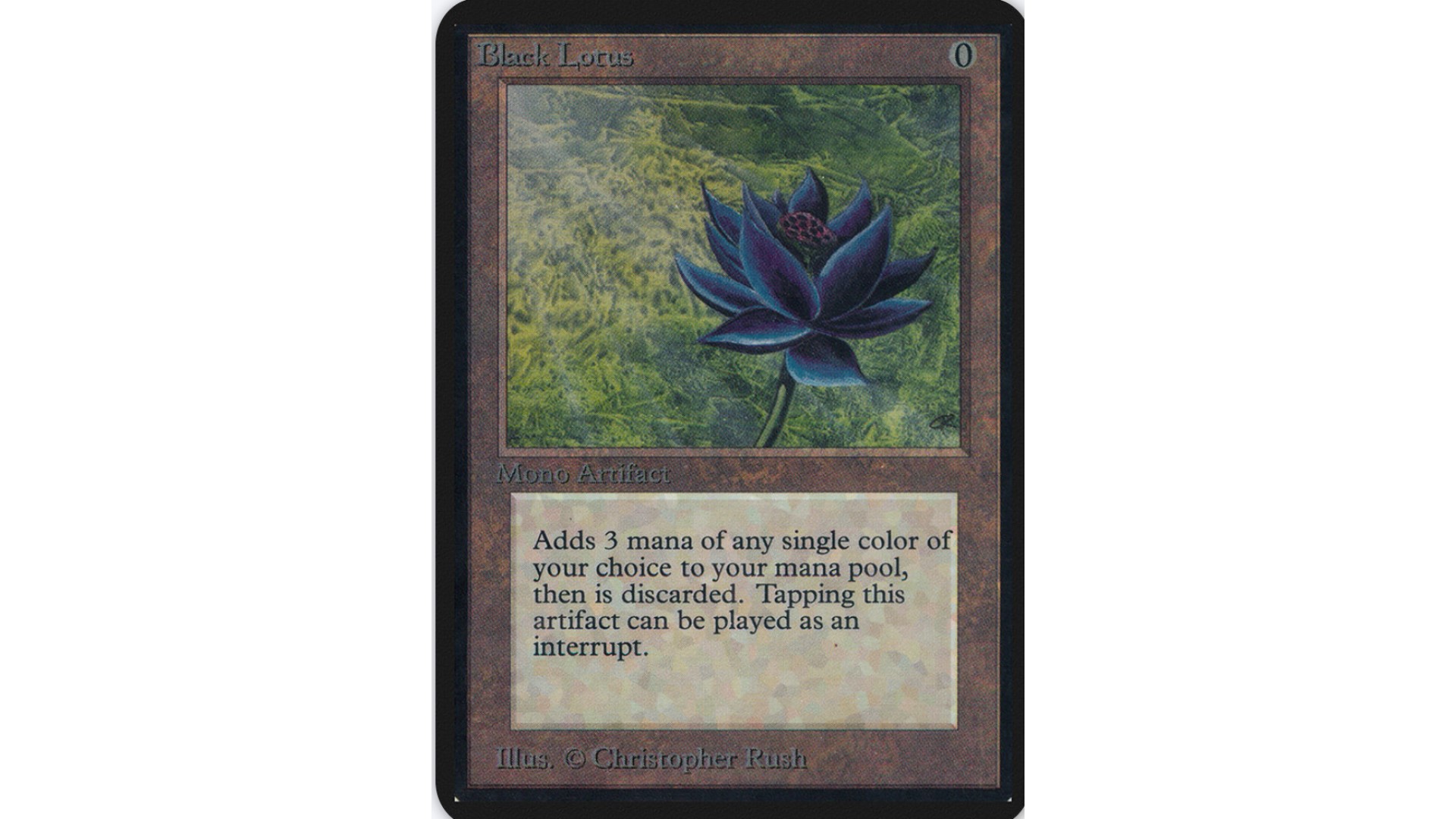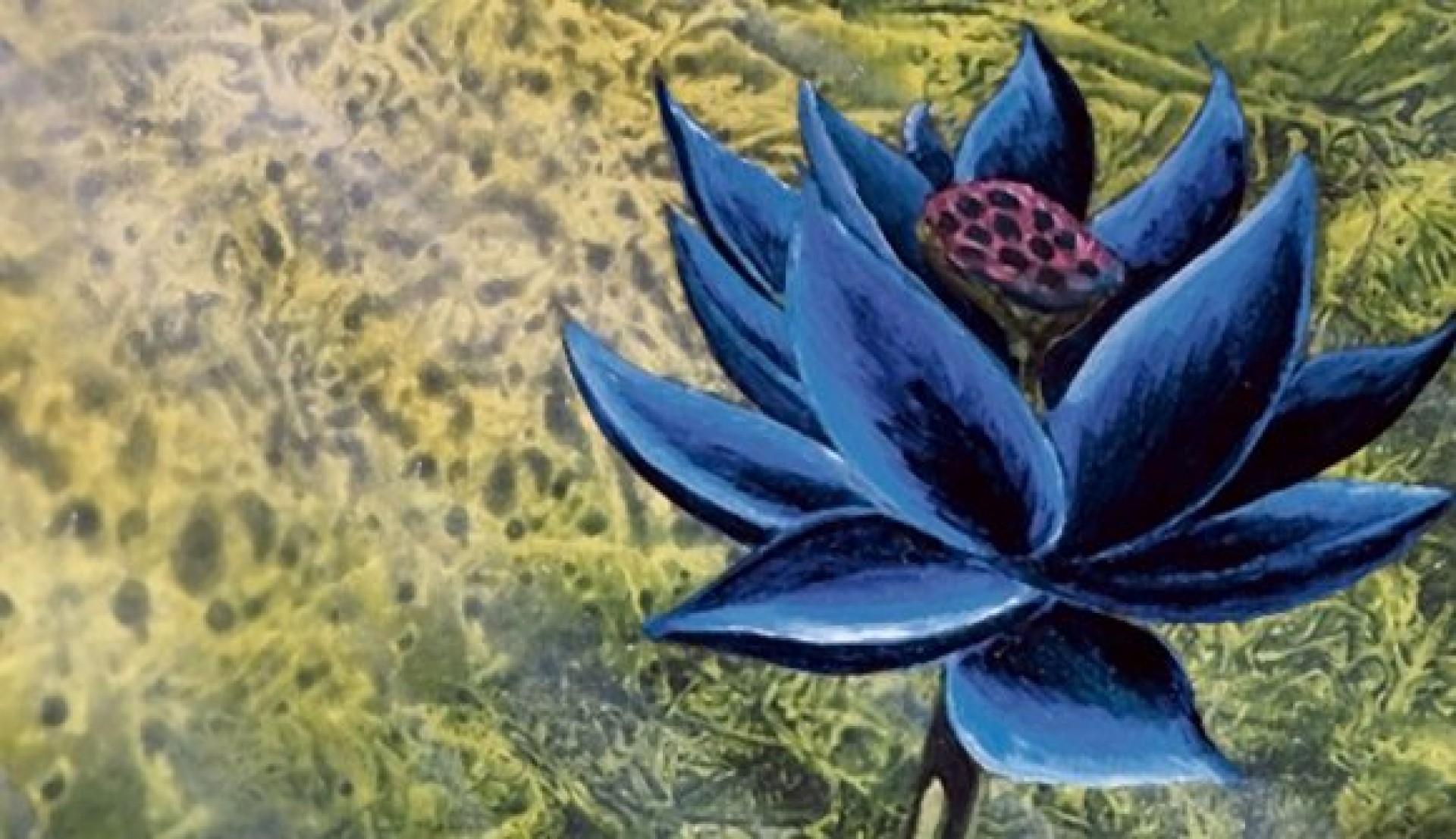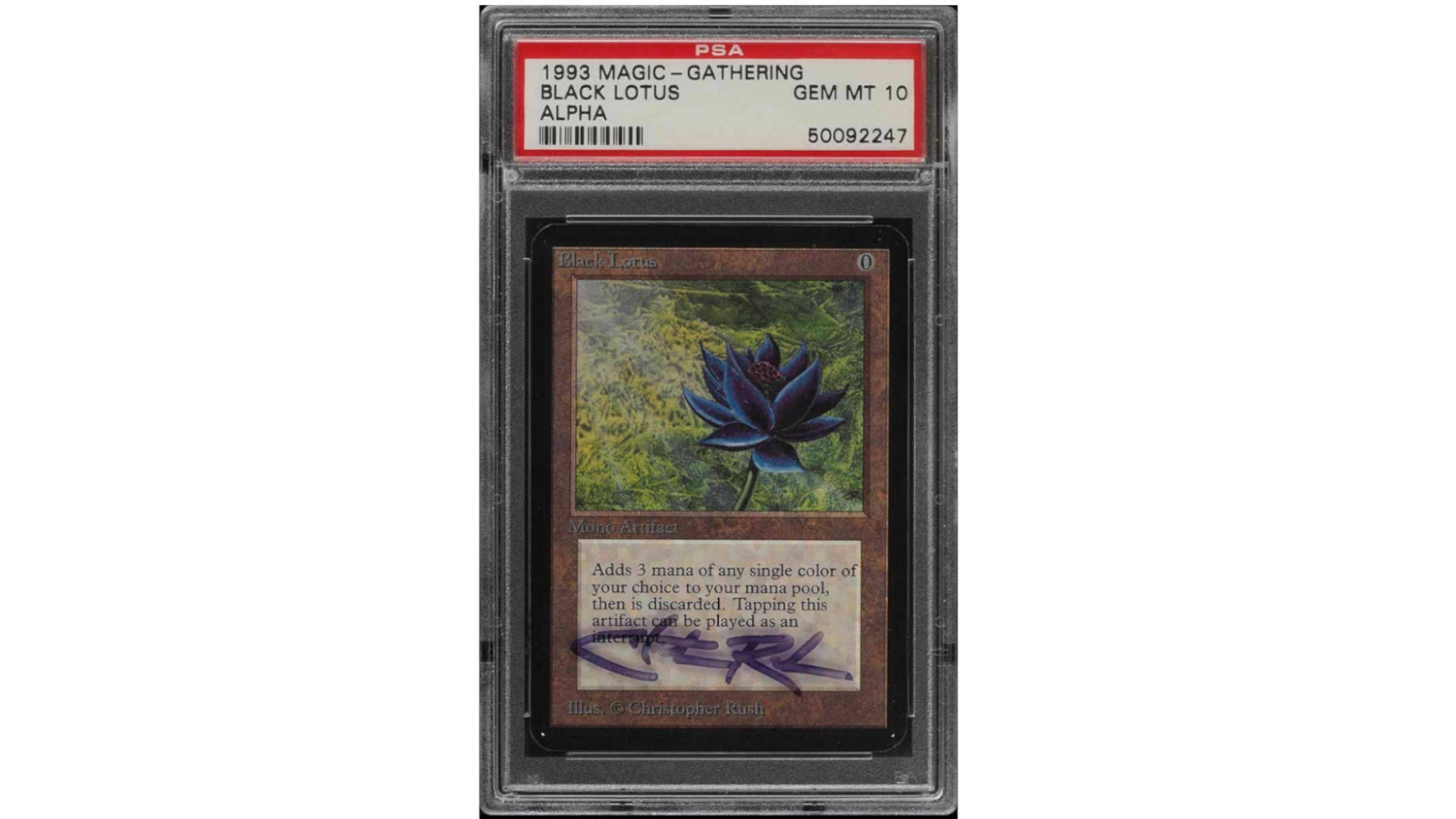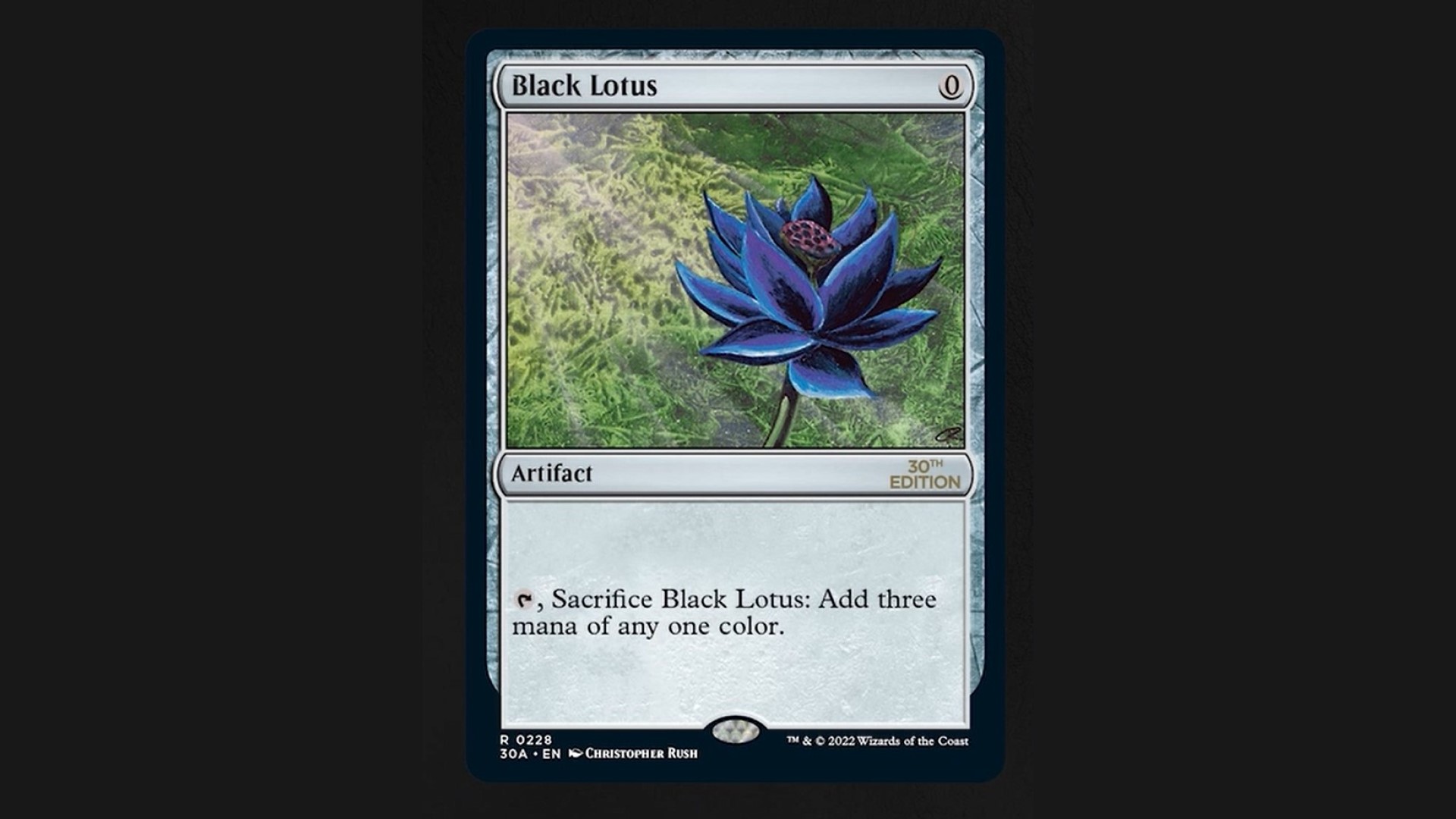The MTG Black Lotus represents everything that’s special about Magic: The Gathering. As a classic card from one of the earliest core sets in the game, it reminds us that MTG pioneered trading card games back in the day. It’s one of the most powerful cards around, so it shows off the awesome potential of a well-designed deck. And it represents the value of trading and collecting cards thanks to its eye-watering tag.
If you want to learn more about the Black Lotus Magic card, you’ve come to the right place. When we’re not keeping a close eye on MTG Arena codes and the MTG 2023 release schedule, Wargamer is thinking about the most expensive Magic cards ever printed. Here you’ll find the colourful history of Magic’s most important flower.
What is the MTG Black Lotus?
Black Lotus is a zero-cost artifact that allows you to add three many of any single colour to your mana pool. Once Black Lotus has generated this mana, you then discard it.
Black Lotus can also be tapped and used as an interrupt, a now-defunct type of MTG card that allowed you to resolve effects even faster than instants. The current Magic: The Gathering rules say all interrupt cards are now treated as instants, and a card with a ‘play as interrupt’ (like Black Lotus) can activate it like any other activated abilities.
MTG Black Lotus history
Black Lotus debuted in MTG’s first core set, Limited Edition, which was released in 1993. Two printings of Limited Edition, known as Alpha and Beta, released that year, and Black Lotus was featured in both. It was also present in Unlimited Edition, another 1993 printing that featured the same cards as Limited Edition Beta.
Tabletop website Crystal Keep once estimated 22,800 copies of Black Lotus were printed: 1,100 Alpha, 3,200 Beta, and 18,500 Unlimited. It’s difficult to estimate how many Black Lotus cards still exist, but it’s safe to say any version of the card is extremely rare. That’s just one factor that makes it so valuable.
Black Lotus is part of a group of Magic: The Gathering cards known as the MTG Power Nine. These nine cards are:
- Ancestral Recall
- Black Lotus
- Mox Emerald
- Mox Jet
- Mox Pearl
- Mox Ruby
- Mox Sapphire
- Timetwister
- Time Walk
The Power Nine are considered the most powerful cards ever created. Because of this, they’ve spent plenty of time on the MTG banlist. They’re only legal in Vintage, and even then they’re restricted to one copy per deck.
Why is the MTG Black Lotus so powerful?
In many trading card games, the simplest cards are often the most broken – just look at how long Pot of Greed has spent on the YuGiOh banlist. Black Lotus lets you create three mana for free. It’s not hard to understand, but it is ridiculously useful.
Mana means everything in Magic: The Gathering; it’s the resource you need to play pretty much any card. You usually gain mana by playing lands, but you’re limited to one per turn – so suddenly being able to generate three mana at no extra cost can speed your game up significantly. Your opponent will be stuck playing one new mana per turn. Suddenly they’re sweating and racing to catch up with your deck.
Once upon a time, you could even earn a first-turn win by stuffing your MTG deck with Black Lotus, Channel, and Fireball cards. Some swift bans in the ‘90s put a stop to this.
MTG Black Lotus price
Black Lotus certainly didn’t start life as an expensive card. According to the first issue of the gaming magazine Scrye, the most you could expect to pay for a Beta Black Lotus in 1994 was $22.50. By the time Scrye issue nine came out in 1995, the high-end price of a Beta Lotus had jumped to $300. Then, in 2004, Scrye was listing the same Beta Lotus for up to $1,250. That’s a 5,455.56% increase in just ten years.
And things only get bigger from there. MTG Goldfish currently estimates an Unlimited Black Lotus (the least rare version) will sell for nearly $18,000. An Alpha Black Lotus signed by Christopher Rush (who created the Black Lotus card art) sold for $511,100 in 2021. This might be the most expensive official MTG card in history, but rapper Post Malone spent even more on a signed artist proof Black Lotus. More specifically, it cost him over $800,000.
No one buys a Black Lotus to play it anymore; this dark little flower is now a status symbol. A player who owns one shows their dedication to the game, their respect for Magic’s history – and the depths of their wallet.
30th Anniversary Edition Black Lotus
There was technically a new printing of the Black Lotus in 2022, but the new versions aren’t legal to play. The 30th Anniversary Edition booster box included four boosters with reprints of Limited Edition Beta cards. Black Lotus was among the reprints, and its original art even decorated the back of each card.
While this may have sounded like a cool way to commemorate Magic’s history, several things sent the MTG community into a rage. Firstly, none of the cards was tournament-legal, meaning fans were paying for boosters full of proxies. Secondly, the box of proxies cost $999. Considering you can buy some cards from Beta for less than this, the possibility of pulling a fake Black Lotus suddenly seemed far less appealing.
